
| Chemin de Saint Jacques (St Chely to Conques) |
A cloud band passed by overnight, shedding a few drops of rain, but that did not stop us waking to another fine morning. It was an interesting breakfast - we were starting to notice a pattern, in that the first conversation of the day in gîtes communal turns around who snored and how loudly, and so on. Breakfast over, we set off for the last longish stage of this walk, descending the cobbled streets of St Chely to cross the Boralde River on the old stone Pont des Pelerins. |
 Looking across the roofs of St Chely to our path up the hills
|
 The medieval Pont des Pelerins at St Chely |
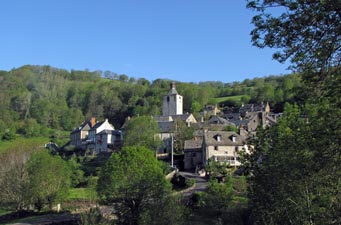 Au revoir Saint Chely |
Although the day would involve a large loss of altitude to reach the Lot River, it started with a climb. Once over the bridge we found ourselves zig-zagging up the sealed road high above the village. Eventually, we left it to follow a footpath leading through dense forest. It was very pleasant traversing the slope on a bed of soft dry dead leaves, with the new growth of the current year forming a bright green canopy, from where the sweet sounds of invisible songbirds wafted across the air. |
||
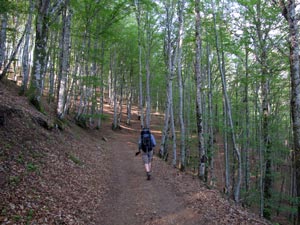 Leaf-littered route through the birch forest |
 Moss-covered wall and tree-trunks |
|
|
||
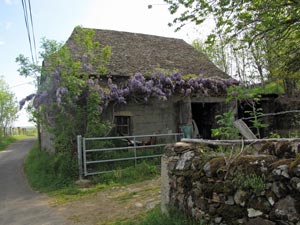 Wisteria-decked farmhouse |
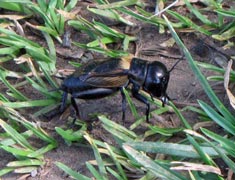 The musician of the fields |
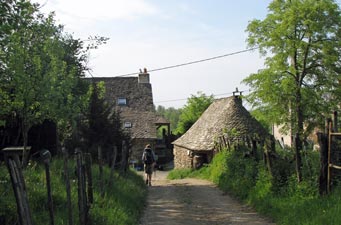 The hamlet of Lestrade |
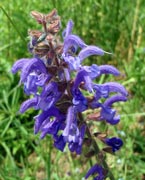 |
 A field full of chirping crickets on a warm spring day |
 |
It was a good break before commencing the descent once again. This time a stony track led us slowly down beneath a shady canopy of chestnuts. The forest thickened even more as we descended an eroded track once again into the valley of the Boralde, though this time much closer to its junction with the Lot. |
||
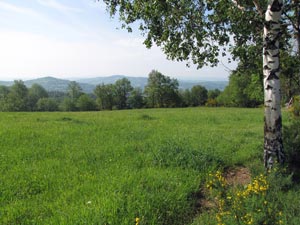 Rural still-life - meadow with birch trunk |
 Track beneath a big chestnut tree |
 In the forest of the Boralde |
Unfortunately, rapid descents into valleys usually mean steep climbs out and such was the case today, as we trudged slowly up a rough gravel track to reach La Roziere. Here, the shady terrace of an auberge overlooking the green hills beyond invited us for lunch - we accepted. |
||
|
|
|
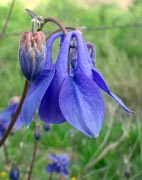 |
While we were eating, the clouds that had begun to appear discretely in the west were now building up into menacing billows of grey - it was time to head on, descending once again past fields of poppies to reach the village of St Come d'Olt - rightfully proud of officially being one of the "plus beaux villages de France". We only just made it - large drops began to fall as we hurried through the narrow cobbled streets to reach the 16th century church with its curiously twisted bell-tower. With several other randonneurs, we took shelter in the church while the heavy rain fell outside - time to sit and admire its magnificent stained-glass windows. |
|
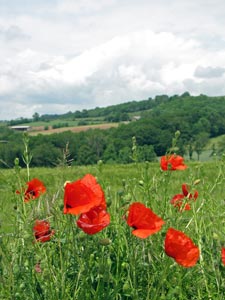 Poppies near St Come |
 The streets of St Come d'Olt |
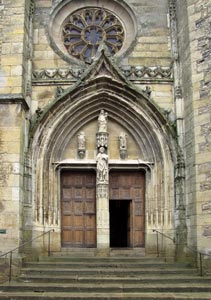 Portico of the church at St Come |
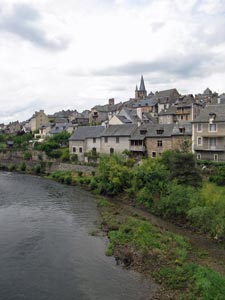 St Come on the banks of the River Lot |
 |
 |
The sun returned and the rain left (in that order) and we set out again, heading out of St Come to cross the bridge over the Lot - turning back to admire one last time the setting of this village on the river. The GR65 turned westward almost immediately to follow the Lot along a quiet sealed road - after the rain the humidity was up and it almost felt tropical. Meanwhile, the grey clouds had regrouped and soon heavy drops began to fall again, forcing us into the shelter of a cypress arch at the entry to a local farm. |
|
Fifteen minutes later, we resumed again in sunshine, walking quickly along the steaming road until we reached a junction in the track - we could either take the high road up a slippery track to the ridge above the river or continue along the sealed road that followed the Lot. The threat of more rain made the choice easy and, despite our aversion to road-walking, we enjoyed the stroll alongside the stone-rippling waters of this tree-lined river. |
|||
 The low road to Espalion |
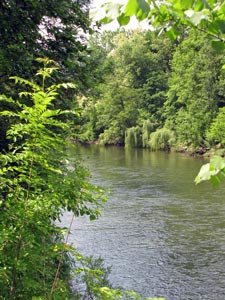 The tree-lined banks of the Lot |
 Ruins of the Chateau de Calmont d'Olt |
 A stretch of the Lot near Espalion |
The low road brought us quickly to Espalion and its splendid setting on a broad calm reach of the Lot; turrets of the old palace and ancient tanners houses lining the river, connected by world heritage listed Le Pont Vieux, an 11th century stone arch bridge. High above the town the ruins of the 10th century Chateau des Seigneurs de Calmont watched over all. |
|
 The 16th century Vieux Palais at Espalion |
 Reflections of riverside houses and Pont-Vieux (the classic photo of Espalion) |
|
Without a doubt, Espalion is a very pleasant place to wind down after a long, hard day on the Chemin de Saint Jacques. |
|
NB We shared a room with a very nice German couple who spoke only a little French and English. It seemed an appropriate moment to bring out my high-school German. After a few sentences it seemed an appropriate moment to put it away again. Their English was certainly better than my German. The point, however, is that with good will and a bit of effort, we can all communicate and share our experiences with one another.
|
It had rained a lot during the night and we were greeted by a sky filled with menacing grey cloud in the morning. We waited a while for a shower to clear before setting out - there was no rush as we had started to slow the walk down. While getting to Conques in two days was feasible and many of our fellow walkers planned to do it, there was no point for us, as the bus we needed to catch from Conques only operated on weekdays. No point rushing to arrive on a Friday and then hang around all weekend - though if you have to hang out, Conques is not a bad place. We still had planned one rest day there at the end of the walk. |
||
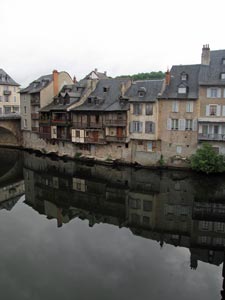 Still waters on a grey day - reflections in the Lot |
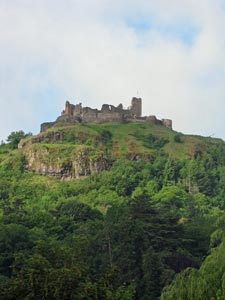 Last glimpse of the Chateau de Calmont d'Olt |
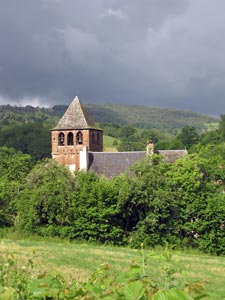 The church of St Pierre at Bessuéjols |
|
Eventually, we were off, crossing the old bridge over the Lot and swinging westward to follow its bank out of town. Not long after we turned away from the river to follow a sealed road along the river flats that led us to the pretty village of Bessuéjouls and its romanesque church.
|
|
From here a short, but sharp climb up through the forest brought us on to the hilltops further back from the river. From our vantage point we could look back far up the Lot Valley to Espalion and its imposing chateau. From the looks of the dark grey clouds, some heavy weather was heading towards the region we had left. Fortunately, ahead it was more promising. |
||
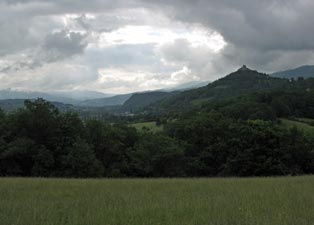 Storms approaching Espalion |
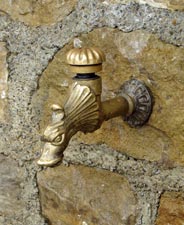 Ornate pilgrim fountain |
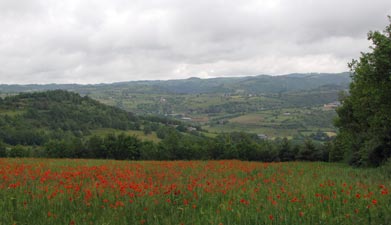 A poppy field on the hill side of the Lot Valley |
|
|
|
|
Patches of sun broke through as we wandered through fields of wheat and rye, before descending once again along a narrow muddy path, first between a thick hedgerow and then back through the forest. This track emerged at Tredou, back on the river flats. |
|||
 |
 |
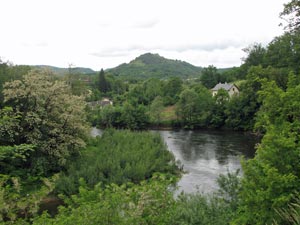 A tranquil bend in the Lot |
|
From Tredou, we crossed a mosaic of rich red soils and green fields before passing through the village of Verrieres, situated on a bend of the Lot. The hills here had closed in to form a small green-walled gorge. A narrow footpath took us up and over a forested spur of this gorge, and a small section of road-walking led us to the splendid setting of Estaing - yet another "plus beaux village de France". |
|||
Across the Lot, the turrets of the Chateau of the seigneurs d'Estaing rose sharply above the old houses, framed by the verdant green of densely forested hills. It was definitely a good spot to take a break for lunch - so we headed across the 16th century Pont des Pelerins for a bite at a riverside cafe. |
|
|
 Estaing and its 15th century chateau |
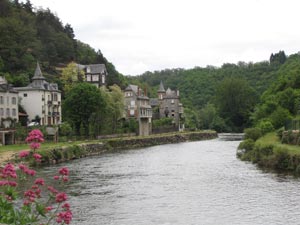 Houses of Estaing lining the Lot |
|
|
Recrossing the bridge, we rejoined the GR65, following a quiet sealed road along the southern bank of the Lot, as it took a large sweeping curve through a second gorge, the verdant walls reflecting in the deep dark green pools of the river.
|
|
|
Soon after we left the gorge, our path turned inland, crossing a sidestream of the Lot, before the start of an unrelenting 4km climb, partly on the road and partly on steep footpaths that cut out the long corners. Reaching a grassy rise at Montegude, we thought the climb was over, but the road continued up - like the last climb of a mountain stage in the Tour de France, every bend seemed to lead to another climb until eventually we crested the hill to reach Fontveille and the gîte rural where we had booked to spend the night. |
||
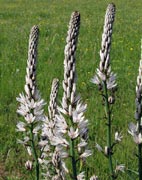 |
 |
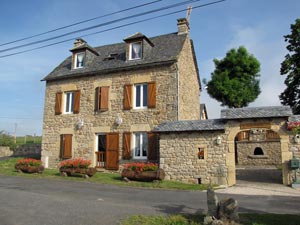 Our gîte rural at Fontveille |
|
|
|||
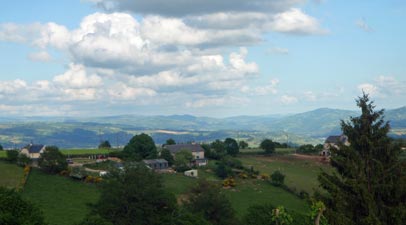 Views across the hills to the distant Aubrac Plateau |
 Full moon over Fontveille |
For the first time, we were in a gîte that was not full. In fact we were the only ones at dinner, which made for an interesting evening of conversation ranging from football to our host's passion for renovating old French farm buildings and turning them into gîtes, all over the heartiest meal we had eaten to date - muscat et olives, potage aux legumes avec croutons et fromage rapé, ragout de chevron avec champignons (accompanied by a rosé from Montpellier), salade avec vinaigrette des noix, assiete de 7 fromages, salade de fruit, tisane de the d'aubrac et eau de vie. The French certainly know how to eat well. As a full moon rose above the horizon, silhouetting the trees, the fair Nello and I had a single thought "c'est bien la vie!".
|
|
|
||
The moon set and the cloud returned, rising from the valley below to shroud our hilltop gite in mist, then continuing upward to evaporate and reveal the countryside in all its glorious shades of dewy green. Our breakfast was as sumptuous as our dinner, so if you want to eat really well on the Chemin de St Jacques, spend at night at the gite rural de Fontveille. |
|
|
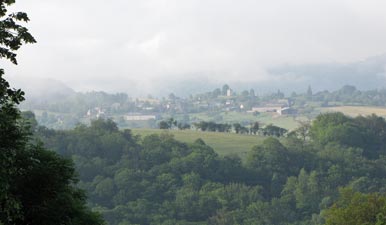 Foggy start to the day at Fontveille |
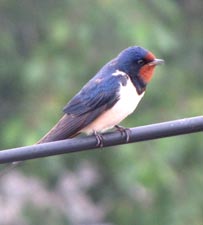 |
|
Our slowdown continued with only 16km ahead of us and, by stopping in Fontveille, we found ourselves between the pulses of pilgrims that follow the traditional stages. For the first time we were alone on the track, with only the songbirds singing and the crickets chirping for company as we undulated along the sealed roads and natural footpaths that led us through field and forest to the village of Golinhac. It was very pleasant to be on our own, though sad to realise that we would no longer meet up with the "companions de chemin" that we had made over the past week of walking. |
||
 Country lane near Massip |
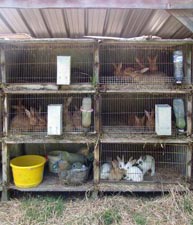 Daube de lapin for dinner? |
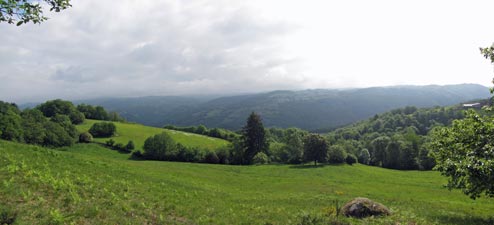 The green hills near Golinhac |
|
|
Passing through Golinhac, on its hilltop balcony overlooking the Lot Valley, we continued westward on quiet roads, some sealed, some gravel, to reach the village of Albusquies - time for a bit of chocolate and orange to boost the energy levels. As we ate, we noticed the sky beginning to fill with dark grey clouds - it was time to head on.
Descending a narrow path and crossing a stream, we pushed on through the fields and tree groves of this undulating plateau. The storm seemed more interested in raining on pilgrims to the east of us, so our pace dropped back to a steadier rhythm again.
|
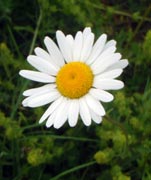 |
 |
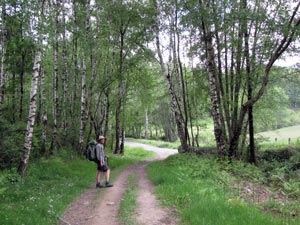 Passing through a birch grove |
As we climbed gently up a gravel road, we met our first walker for the day, heading in the opposite direction. He told us we were pilgrims no. 105 and 106 that he had passed since leaving Conques, some 20km down the track! We were glad to have made a reservation for the week-end there. At Campagnac on the edge of the plateau, a winding sealed road led us down into the valley of the Daze River, passing the hamlets of La Soulié and Carbonies on the way. |
|
|
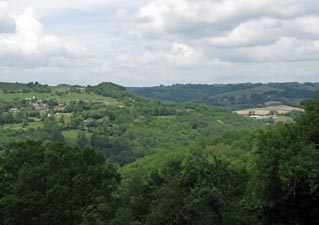 View over the Daze Valley from Carbonies |
 |
|
We stopped briefly at La Soulié, where a local resident had set up a table, chairs and umbrella with pots of hot coffee or tea (pay what you want into a box). It was nice to enjoy the coffee and the kindness, while looking out over the lush green surrounds. |
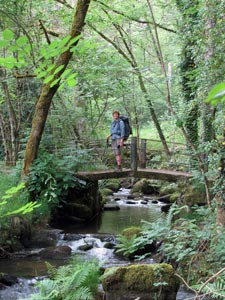 Crossing a rocky stream near Espeyrac |
A couple of narrow footpaths then led us away from the road to descend more steeply through a forest and alongside a babbling stream. Crossing the stream on a little iron bridge, we reversed direction on the other side to traverse along an old stone-walled terrace that led us into Espeyrac, perched on a rocky promontory on the side of the valley. |
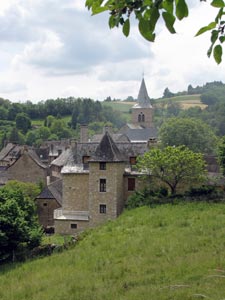 The village of Espeyrac |
|
 |
 |
||
It was only lunchtime, but the gîte communal where we were staying had a large area of lawn, great for whiling the rest of the day away and the enjoying the tranquil setting of the village. Later on we wandered down to the local epicerie to get some supplies - tonight we would cook for ourselves and make a very simple meal to try and balance the rich fare of our previous evening.
|
Our last and shortest day on the Via Podiensis (as the section of the pilgrimage from Le Puy is known) dawned - only 12km to Conques and, while there was a distinct haze in the air, the sun was shining. It promised to be a good ending to a great walk. Leaving the gite, we meandered past the local Saturday market, checking out the bric-a-brac old and new on sale, before heading off. The climb up from Espeyrac back onto the plateau was upon us almost as soon as we left the narrow cobbled streets of the village and crossed the Daze rivulet just below. First a steep footpath, then alongside a sealed road, then another footpath and we were soon in next village of Senergues, with its 14th century square tower. |
||
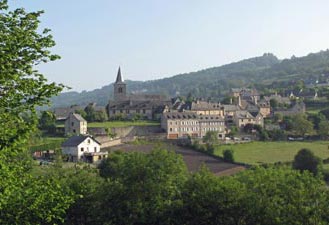 Farewell view of Espeyrac |
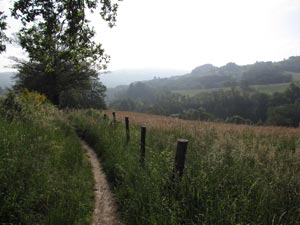 Hazy morning on the track |
 The church and 14th century tower at Senergues |
Another climb leading up to a gravel road brought us to the top and we wandered along between pine forest and pastures, the resinous scent of the pine replaced by that of freshly mown hay. A little further on, a narrow footpath led us across the wheatfields, along a hedgerow of blackberries and sweet-scented broom. Finally we emerged from the fields to follow yet another sealed road across this undulating plateau, deeply cut by river valleys. |
|
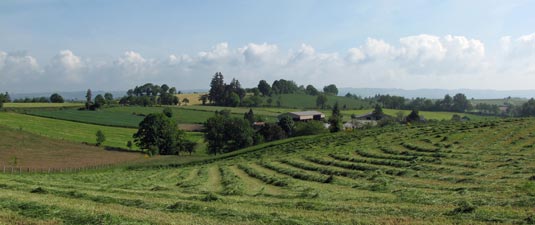 Freshly mown hay-fields near Saint Marcel |
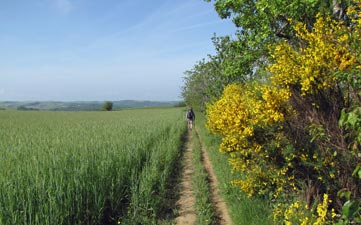 Passage alongside a wheat crop |
Passing through the village of Saint Marcel, views began to open up to the south over the ravine of the Ouche River, clad in dense green forest. A little later, a chemin blanc led us away from the road and down towards the ravine. This changed quickly to a narrow rocky footpath, etched deep into the slope, that wound steeply down into the valley of the Ouche - mostly a dark tunnel through the dense forest, but sometimes opening out to provide glorious views of the far side. |
|
|
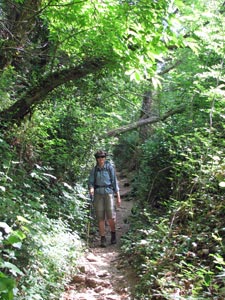 Descent into the Ouche Valley |
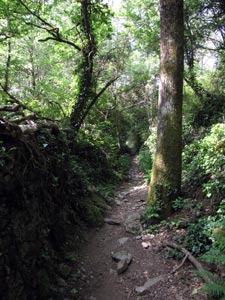 The deeply eroded track leading to Conques |
|
Suddenly we emerged from the forest and the village of Conques, yet another of the "plus beaux villages de France", lay ahead - a magnificent setting of lauze-roofed cottages, clinging to the steep side of the valley at the confluence of the Dourdou and Ouche Rivers, and dominated by the towers of Sainte Foy de Conques - its magnificent 12th century abbey. This was a fitting place to end a long walk. |
||
We found our accommodation, in one of the classic old houses in a steeply cobbled side-street, found the boulangerie and made ourselves some lunch before exploring our surrounds. Conques is a strange village - almost catering more to tourists than to locals. There are lots of shops selling artisanal products and craft, but few selling food, other than flash restaurants. |
|
|
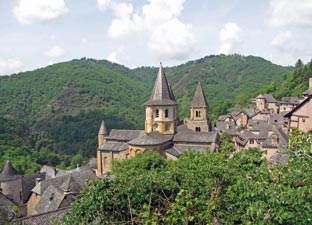 First view of the roofs of Conques |
 Conques viewed from the west |
|
The highlight of Conques though is the basilica, with its 26m high cupola, vaulted roof and carved columns, built over a 100 year period to venerate a 12-year girl martyred in nearby Agen, and whose relics were stolen by the monks of Conques in 886. Truth is always stranger than fiction. |
||
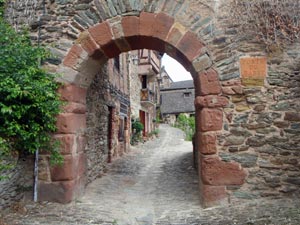 The Porte du Barry - entry of old Conques |
 Roman bridge over the Dourdou - our furthest point along the Via Podiensis |
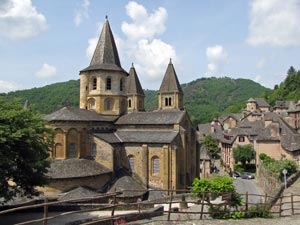 The Abbaye de Sainte Foy in Conques |
|
We were able to eat at the gite of the Abbaye Ste Foy that night, thanks to an invitation from one of our fellow pilgrims. Only then, as we shared a meal with over 100 others in the old monks' quarters, did we realise how many people actually make this pilgrimage. |
|
|
|
|
|
If you come to Conques, you must visit the basilica for the organ recital at night - the illumination rising and falling with the crescendo of the organ, revealing a simplicity of architecture that belies the richness of medieval sculpture on column and wall. To experience this from high up in the tribune overlooking the vaste space of the building was one of those moments that is felt but can't quite be described.
|
|
|
NB The following morning was our rest day after ten days of walking - as we sat in bed sipping a hot cup of tea, our hearts went out to our fellow pilgrims who had already headed on and into the steadily falling rain! We had truly been fortunate with the weather, but also fortunate in getting to know, however briefly, the people who were making the same journey. The track is not always a place for first names and as we walked we gave many of our companions a "nom de chemin" - so thanks to all of you for your company, in particular, les Quebecois (heading all the way to Santiago), les trois mousquetaires, la jeune, Monsieur la Carte, M/Mme shortshorts, Die Pilger, l'Allemande, les Belges and Sainte Catherine des Ampoules. We hope that you enjoyed the walk as much as we did.
|